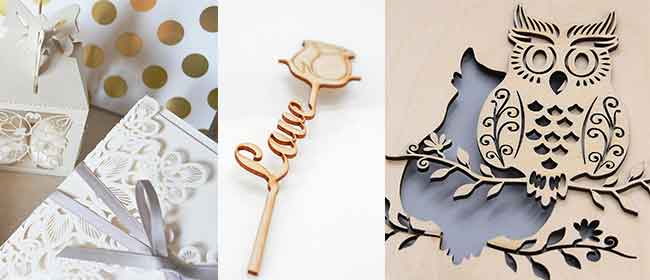
Laser cutting has rapidly gained popularity among creative DIY enthusiasts.
Laser cutting has quickly become a favorite tool among DIYers, allowing people to create precise, customized projects from a wide range of materials. Whether you’re crafting home décor, making personalized gifts, or developing educational tools for kids, laser cutting offers endless possibilities. With increasing accessibility and affordability, many hobbyists are turning to this technology to bring their ideas to life. In this guide, we’ll explore everything a beginner needs to know about laser cutting and how it can elevate your DIY projects.
What is Laser Cutting?
Laser cutting is a precise manufacturing process that uses a high-powered laser beam to cut, engrave, or etch materials such as wood, acrylic, cardboard, fabric, and even metal. The laser focuses intense heat on the material, causing it to vaporize or melt away in a highly controlled way. This results in smooth, clean cuts that are perfect for intricate designs and detailed patterns.
There are several types of laser cutters available, but two of the most popular are CO2 laser cutters and diode lasers. CO2 lasers, in particular, are commonly used for cutting and engraving wood, acrylic, and other non-metallic materials due to their precision and power. If you are new to the world of laser cutting, the CO2 laser cutter might be an ideal choice for a range of DIY projects, as it is highly versatile and offers exceptional quality for both cutting and engraving.
Laser cutting offers a wide range of materials you can experiment with. You can use it for crafting in wood, leather, fabric, cardboard, and even paper. The variety of materials opens up a world of creative possibilities for any DIY enthusiast looking to explore this fascinating technology.
Why DIY Enthusiasts Should Consider Laser Cutting
Laser cutting is not only a tool for professionals; it’s a perfect fit for DIY enthusiasts seeking to add a personal touch to their creations. One of the key advantages of laser cutting is its ability to create highly customized designs. Whether you want to make personalized home décor or unique gifts, laser cutting can help you craft exactly what you envision. You can create intricate patterns, detailed engravings, and even 3D objects that would be difficult or time-consuming to achieve by hand.
Precision is another reason laser cutting is a game-changer for DIYers. The laser cutter’s fine detail ensures that even the most delicate designs come out perfectly. This means you can cut out designs with complex curves, sharp angles, and fine lines that are difficult to replicate with traditional cutting methods.
Efficiency is another significant benefit of laser cutting. Once your design is prepared, the laser cutter will execute it quickly and with minimal material waste, making it an excellent choice for both small and large projects. Laser cutting also saves you from the tedium of manual crafting, allowing you to focus on the creative aspects of your projects.
Laser cutting also offers incredible versatility. Whether you’re interested in making home décor items, customized jewelry, educational tools, or personalized gifts, laser cutting opens up endless possibilities for creative expression. For instance, with a laser cutter for wood, you can create beautifully detailed wall art, shelves, or even custom furniture. The possibilities are endless.
Essential Tools and Equipment for Laser Cutting
To begin with laser cutting, the first thing you’ll need is access to a laser cutter. There are various models available on the market, ranging from affordable desktop versions to larger, more advanced machines. A CO2 laser cutter is an excellent choice for beginners, offering a balance of power, precision, and ease of use. These machines are versatile enough to handle a wide variety of materials, including wood, acrylic, and cardboard, making them perfect for DIY projects.
Along with the laser cutter itself, you’ll need design software to create or modify your projects. Popular software options for laser cutting include Adobe Illustrator, CorelDRAW, and free programs like Inkscape. These programs allow you to create vector-based designs that are compatible with the laser cutter.
In terms of materials, wood, acrylic, leather, and cardboard are popular choices for laser cutting, but the material you choose will depend on the project you’re working on. For example, if you’re designing a custom sign or home décor piece, wood or acrylic might be the best option. If you’re making a wallet or keychain, leather could be a great material to work with.
It’s important to keep safety in mind when using a laser cutter. Always follow the manufacturer’s safety instructions, wear protective glasses, and ensure that your workspace is well-ventilated. A laser cutter for wood can produce smoke or fumes, especially when cutting thick materials, so having proper ventilation or using an air filtration system is essential.
Getting Started with Your First Laser Cutting Project
Now that you’re familiar with the tools and equipment, it’s time to start your first laser cutting project. As a beginner, it’s a good idea to start with simple designs that require basic cuts, such as keychains, bookmarks, or coasters. These types of projects are ideal for learning how to use the laser cutter without being overwhelming.
When designing your first project, you can either create your own design from scratch or use pre-made free laser cutting files available online. Websites like DesignFind offer a variety of free templates that can be downloaded and used for laser cutting projects, helping you jump-start your creative process without needing to start from scratch. Once you’ve chosen or created your design, upload it into the laser cutter’s software and adjust the settings according to the material you’re using.
Setting up the laser cutter requires a bit of preparation. You’ll need to adjust the machine’s settings based on the thickness of the material you’re using, as well as the type of cut or engraving you want. If you’re cutting thicker materials, such as plywood or thick acrylic, you may need to perform multiple passes to achieve the desired depth. It’s also recommended to do a test cut on a scrap piece of material to ensure your settings are correct before moving to your final piece.
Once your laser cutter is set up, it’s time to start cutting! Once the cutting process is complete, you can finish your project with paint, engraving, or other finishing touches. For instance, after cutting out a wooden sign, you might want to sand the edges, apply a stain, or add some personalized engraving.
Popular Laser-Cut Projects for Beginners
There are countless creative projects you can tackle with a laser cutter, even as a beginner. Personalized gifts are always a hit, and a laser cutter makes it easy to create custom keychains, coasters, and photo frames. These projects are relatively simple to design but can have a huge impact when given as gifts. You can also create custom home décor, like personalized wall art, engraved signs, or even 3D sculptures.
For those interested in educational tools, laser cutting is an excellent way to create learning aids. You can design and cut out puzzles, educational shapes, or even alphabet letters to help young children with their learning. Laser-cut puzzles are particularly fun, as you can create designs that are both educational and entertaining.
If you’re a more advanced DIY enthusiast, you can explore more complex projects such as creating custom furniture pieces, lamp designs, or intricate jewelry. The laser cutter gives you the ability to work with a variety of materials to make these pieces both functional and visually striking.
Where to Find Resources and Inspiration for Laser Cutting
One of the best things about laser cutting is the vast community of enthusiasts and creators who are eager to share their knowledge. You can find plenty of inspiration and resources online, from free design files to tutorials and tips. Websites like DesignFind offer a collection of free laser cutting files that you can use to create a wide range of projects. If you’re looking for specific designs, platforms like Etsy or Thingiverse also have laser cutting templates for sale.
In addition to online resources, there are many workshops, courses, and forums dedicated to laser cutting. These spaces are perfect for learning new techniques, getting feedback on your projects, and connecting with like-minded creators. Many local maker spaces also offer classes and access to laser cutters, providing hands-on experience in a supportive environment.
Tips for Advancing Your Laser Cutting Skills
Once you’ve gained some experience with laser cutting, you’ll want to take your skills to the next level. One way to do this is by experimenting with different materials. Each material, whether it’s wood, leather, or acrylic, reacts differently to the laser cutter. By experimenting, you can learn how to achieve different finishes and effects based on the material you’re using.
Another tip is to explore more complex designs. Once you’re comfortable with basic projects, try your hand at intricate laser engraving or 3D objects. With the right settings, a CO2 laser cutter can achieve stunning engravings that add depth and texture to your projects. Engraving on wood or acrylic can transform a simple object into a personalized masterpiece.
Conclusion
Laser cutting is an exciting and versatile tool that can take your DIY projects to new heights. Whether you’re just starting out or looking to refine your skills, laser cutting offers endless creative possibilities. By starting with simple projects, using resources like free laser cutting files, and experimenting with different materials, you can quickly master the art of laser cutting. So, grab your design files, fire up your laser cutter for wood, and get ready to create something amazing!
 My Favourites
My Favourites









Speak Your Mind